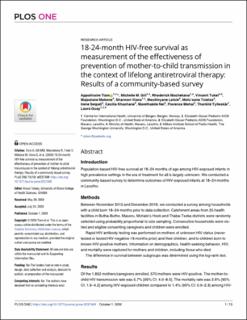| dc.contributor.author | Tiam, Appolinaire | |
| dc.contributor.author | Gill, Michelle | |
| dc.contributor.author | Machekano, Rhoderick | |
| dc.contributor.author | Tukei, Vincent | |
| dc.contributor.author | Mokone, Majoalane | |
| dc.contributor.author | Viana, Shannon | |
| dc.contributor.author | Letsie, Mosilinyane | |
| dc.contributor.author | Tsietso, Mots'Oane | |
| dc.contributor.author | Seipati, Irene | |
| dc.contributor.author | Khachane, Cecilia | |
| dc.contributor.author | Nei, Marethabile | |
| dc.contributor.author | Mohai, Florence | |
| dc.contributor.author | Tylleskär, Thorkild | |
| dc.contributor.author | Guay, Laura | |
| dc.date.accessioned | 2021-06-29T13:52:06Z | |
| dc.date.available | 2021-06-29T13:52:06Z | |
| dc.date.created | 2020-12-14T22:13:32Z | |
| dc.date.issued | 2020 | |
| dc.Published | PLOS ONE. 2020, 15 (10), . | |
| dc.identifier.issn | 1932-6203 | |
| dc.identifier.uri | https://hdl.handle.net/11250/2762401 | |
| dc.description.abstract | Introduction
Population-based HIV-free survival at 18–24 months of age among HIV-exposed infants in high prevalence settings in the era of treatment for all is largely unknown. We conducted a community-based survey to determine outcomes of HIV-exposed infants at 18–24 months in Lesotho.
Methods
Between November 2015 and December 2016, we conducted a survey among households with a child born 18–24 months prior to data collection. Catchment areas from 25 health facilities in Butha-Buthe, Maseru, Mohale’s Hoek and Thaba-Tseka districts were randomly selected using probability proportional to size sampling. Consecutive households were visited and eligible consenting caregivers and children were enrolled.
Rapid HIV antibody testing was performed on mothers of unknown HIV status (never tested or tested HIV-negative >3 months prior) and their children, and to children born to known HIV-positive mothers. Information on demographics, health-seeking behavior, HIV, and mortality were captured for mothers and children, including those who died.
The difference in survival between subgroups was determined using the log-rank test.
Results
Of the 1,852 mothers/caregivers enrolled, 570 mothers were HIV-positive. The mother-to-child HIV transmission rate was 5.7% [95% CI: 4.0–8.0]. The mortality rate was 2.6% [95% CI: 1.6–4.2] among HIV-exposed children compared to 1.4% (95% CI: 0.9–2.3) among HIV-unexposed children. HIV-free survival was 91.8% [95% CI: 89.2–93.8] among HIV-exposed infants. Disclosure of mother’s HIV status (aOR = 4.9, 95% CI: 1.3–18.2) and initiation of cotrimoxazole prophylaxis in the child (aOR = 3.9, 95% CI: 1.2–12.6) were independently associated with increased HIV-free survival while child growth problems (aOR = 0.2, 95% CI: 0.09–0.5) were independently associated with reduced HIV-free survival.
Conclusion
Even in the context of lifelong antiretroviral therapy among pregnant and breastfeeding women, HIV has a significant effect on survival among HIV-exposed children compared to unexposed children. Lesotho has not reached elimination of HIV transmission from mother to child. | en_US |
| dc.language.iso | eng | en_US |
| dc.publisher | Public Library of Science. | en_US |
| dc.rights | Navngivelse 4.0 Internasjonal | * |
| dc.rights.uri | http://creativecommons.org/licenses/by/4.0/deed.no | * |
| dc.title | 18-24-month HIV-free survival as measurement of the effectiveness of prevention of mother-to-child transmission in the context of lifelong antiretroviral therapy: Results of a community-based survey | en_US |
| dc.type | Journal article | en_US |
| dc.type | Peer reviewed | en_US |
| dc.description.version | publishedVersion | en_US |
| dc.rights.holder | Copyright 2020 Tiam et al. | en_US |
| dc.source.articlenumber | e0237409. | en_US |
| cristin.ispublished | true | |
| cristin.fulltext | original | |
| cristin.qualitycode | 1 | |
| dc.identifier.doi | 10.1371/journal.pone.0237409 | |
| dc.identifier.cristin | 1859775 | |
| dc.source.journal | PLOS ONE | en_US |
| dc.source.40 | 15 | |
| dc.source.14 | 10 | |
| dc.identifier.citation | PLOS ONE. 2020, 15 (10), e0237409. | en_US |
| dc.source.volume | 15 | en_US |
| dc.source.issue | 1o | en_US |

